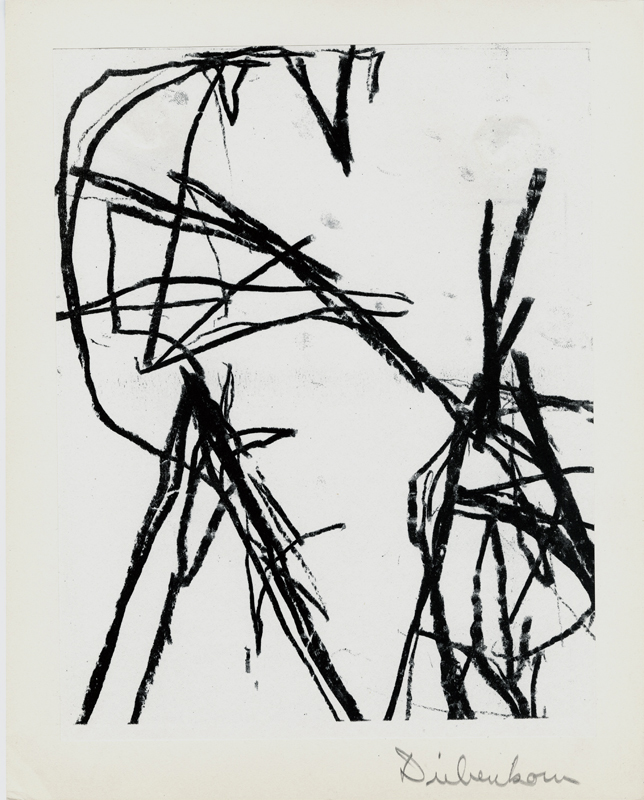This untitled abstract expressionist lithograph was drawn directly onto a flexible aluminum or paper plate in 1948 by American artist, Richard Clifford Diebenkorn. It was included in the Drawings portfolio of offset-printed lithographs created by San Francisco Bay Area artists Diebenkorn, James Budd Dixon, John Hultberg, Walter Kuhlman, Frank Lobdell, and George Stillman. Most of the artists were students at the California School of Fine Arts, some had studios in the ICB building in Sausalito, and all exhibited their work at the Seashore Gallery of Modern Art in Sausalito. Drawings was conceived by the group in an effort to stave off the closure of their gallery as there were limited venues for exhibiting non-representational work.
The artists were given greasy crayons to draw on the "plates" which were then given to Eric T. Ledin of Mill Valley who printed on antique-white Dictationbond paper by Fox River using a Multilith offset press. The impressions were tipped onto a sheet of wove cartridge paper and the artists signed the support sheet or the actual print. Black construction paper folios were created and labeled: Drawings / Dixon / Diebenkorn / Hultberg / Kuhlman / Lobdell / Stillman / Published by Eric T. Ledin Mill Valley Calif.
The Dictationbond sheets measure 11 x 8-1/2 inches and the support sheets measure 12-3/4 x 10-1/8 inches. Drawings is considered the first Abstract Expressionist portfolio created in the United States.
Richard Clifford Diebenkorn, painter, printmaker, and teacher, was born 22 April 1922 to Richard and Dorothy Diebenkorn in Portland, Oregon. Two years later his family moved to San Francisco where they lived in the Ingleside Terraces neighborhood. Diebenkorn attended Stanford University and studied art at the University of California Berkeley as an undergraduate. He enlisted in the U.S. Marine Corps on 27 May 1942 and was transferred to active duty in the fall of 1943.
In January 1946, Diebenkorn enrolled for a semester at the California School of Fine Arts (CSFA) under the G.I. Bill and studied with David Park, Clay Spohn and Hassel Smith. He received a $1,200.00 Albert Bender fellowship which allowed him to spend the next several months on the east coast. In the Spring of 1947, Diebenkorn returned to the Bay Area where he lived and worked in Sausalito. That same year he also joined the faculty of the California School of Fine Arts and met John Hultberg and Frank Lobdell. In 1948, he joined in the efforts of fellow artists George Stillman, James Budd Dixon, Walt Kuhlman, Lobdell and Hultberg to create offset lithographs for the Abstract Expressionist portfolio Drawings. They had planned the portfolio as a fundraiser for the Seashore Gallery of Modern Art in Sausalito which showed their work.
In 1950 Diebenkorn moved to Albuquerque to attend the University of New Mexico where he received his Master’s degree in 1952. He then taught for a year at the University of Illinois in Urbana. He returned to the San Francisco Bay Area in 1953, settled in Berkeley, and began his Berkeley series of oil paintings. In winter 1954, Diebenkorn received the Abraham Rosenberg Fellowship for Advanced Studies in Art which allowed him to paint full time and, in spring, he was included in the exhibition Younger American Painters at the Solomon R. Guggenheim Museum in New York.
Diebenkorn abandoned Abstract Expressionism for working with the figure. He became one of the leaders in Bay Area figurative painting along with David Park, Rex Ashlock, Elmer Bisochoff, Glenn Wessels, Wayne Thiebaud, Raimonds Staprans, and James Weeks.
A man of many interests, Diebenkorn returned to printmaking in 1961 when he was guest artist at the Tamarind Lithography Workshop in Los Angeles. He completed a series of lithographs in the spring of 1962 and by winter of the same year he was working in intaglio at Kathan Brown’s Crown Point Press. In 1977 he returned to working with Brown and made yearly prints at Crown Point Press.
In 1966, Diebenkorn moved to Santa Monica Canyon in Los Angeles and rented a small studio near the beach in the Ocean Park neighborhood of Santa Monica. He joined the faculty of the University of California Los Angeles as a professor of art. He began his Ocean Park series of paintings which brought critical acclaim.
Diebenkorn was elected an Associate of the National Academy of Design in 1979 and elevated to Academician in 1982. He was also elected to the American Academy of Arts and Letter in 1985. He was the recipient of numerous honorary doctorates and was made a Fellow of the Rhode Island School of Design in Providence.
Richard Diebenkorn is represented in numerous collections within the United States, including the High Museum of Art, Atlanta, Georgia; the Museum of Fine Arts Boston, Massachusetts; the Brooklyn Museum, New York; the Art Institute of Chicago, Illinois; the Cleveland Museum of Art, Ohio; the Nelson-Atkins Museum of Art, Kansas City, Missouri; the Los Angeles County Museum of Art, California; the Metropolitan Museum of Art, the Museum of Modern Art, and the Whitney Museum of American Art, New York; the Oakland Museum of California; the Pennsylvania Academy of the Fine Arts, Philadelphia; the Crocker Art Museum, Sacramento, California; the San Antonio Museum of Art, Texas; the Fine Arts Museums of San Francisco and the San Francisco Museum of Modern Art, California; the San José Museum of Art, California; the New Mexico Museum of Art, Santa Fe; and the National Gallery of Art and the Smithsonian American Art Museum, Washington, D.C.
Richard Clifford Diebenkorn died 30 March 1993 in Berkeley, California.
Adam Gopnik wrote this tribute to Diebenkorn after this death in The New Yorker: “Diebenkorn had been, in an unpretentious way, one of the key figures in a great transformation that took place in American Art over the past quarter century: the rise of California from a provincial backwater to an artmaking capital equal to New York.”



